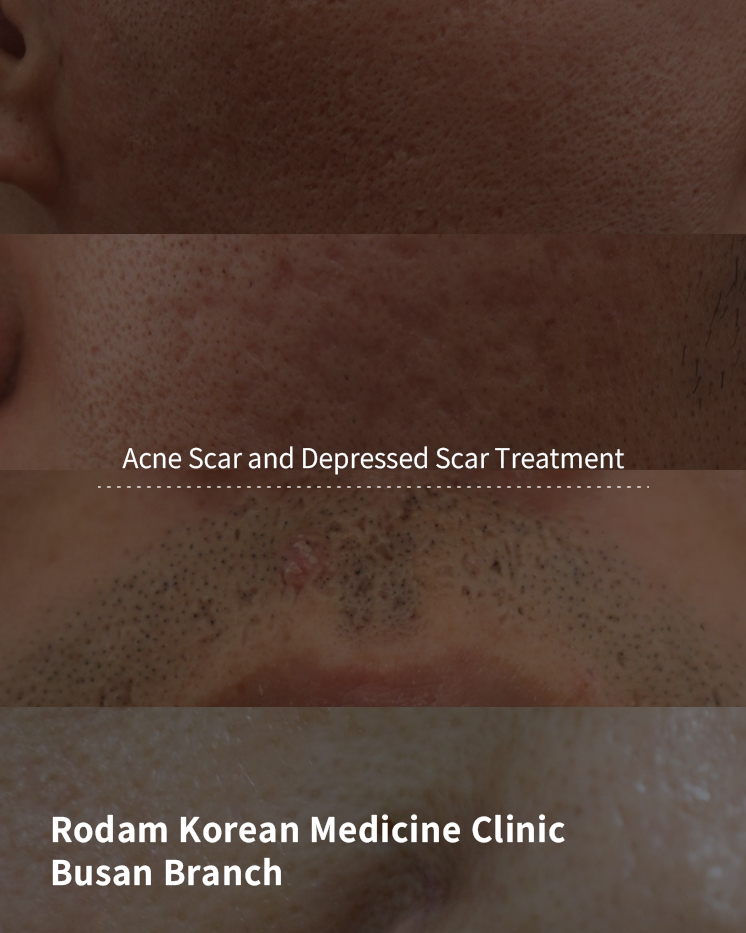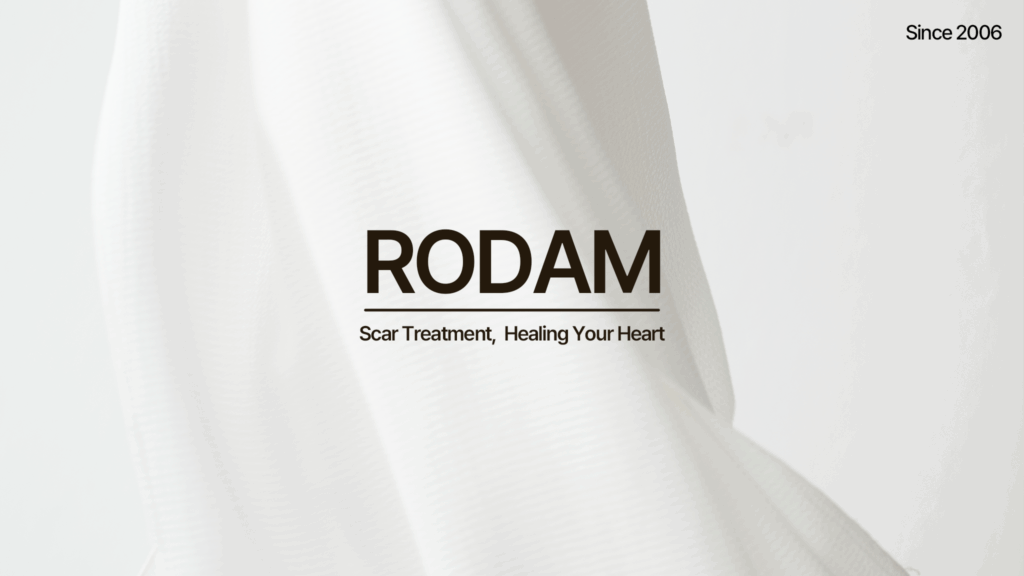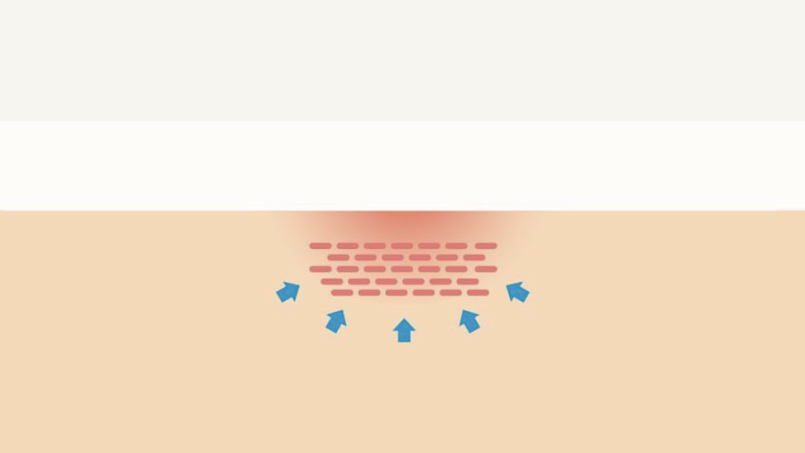
Rodam Korean Medicine Clinic Cheonan Branch, Acne Scar and Depressed Scar Treatment with Coratherapy

Even at a Korean Medicine Clinic, acne scars on the face can be treated using acupuncture.
By creating artificial wounds in the dermis layer of depressed scars, the principle is to help the tissue regenerate in the scarred area.
This is possible not only for acne scars, but also for chickenpox scars, mole removal scars, and scratch scars.
Hello. This is Doctor Kwangil Paeng from Rodam Korean Medicine Clinic Cheonan Branch.
Acne can occur for various reasons, and if treatment is delayed or managed incorrectly, it often remains as depressed scars.
Many people visit us for treatment because they are stressed by these depressed acne scars.
And most of those who are stressed by acne scars are either dissatisfied with previous treatments or have given up, thinking that depressed scars are difficult to treat.
However, Rodam Korean Medicine Clinic’s Coratherapy treatment is different.
Instead of facial scar removal surgery, we can treat depressed scars on the face using acupuncture.
By creating artificial wounds in the dermis layer of the depressed scar, this method helps the tissue fill in the scarred area. This is possible not only for acne scars, but also for chickenpox scars, mole removal scars, scratch scars, and suture scars.
If you are worried about depressed acne scars on your face, you may have looked into Coratherapy methods, effects, and prices. I will explain them in detail.
” Scar Eraser Coratherapy“

1. Stimulate the inside of the depressed scar to create space for new tissue to grow.

2. The stimulation from Coratherapy promotes regeneration, allowing new tissue to fill in from within the skin.

3. With repeated procedures, the new tissue completely fills in, treating even deep depressed scars.
Coratherapy is, simply put, a procedure that stimulates sunken or depressed scar areas where skin regeneration has stopped, using acupuncture to help new tissue regenerate.
Therefore, it is possible to treat not only acne scars but also chickenpox scars, nail scars, scratch scars, suture scars, and various other types of depressed scars.
However, since each patient’s skin condition and type, as well as the shape, depth, and area of the scar, are all different, we proceed with sufficient consultation before planning and performing the procedure.
Let me show you various cases of acne scar treatment from patients who visited Rodam Korean Medicine Clinic Cheonan Branch.
(* Only pre-treatment photos are shown; before-and-after comparison photos can be found in the clinical report postings.)
<CASE 1>
Pre-treatment photo of boxcar-type scars with clear borders and narrow, deep ice pick-type scars centered around pores
(Male in his 30s, 6 sessions of Coratherapy, 2017.06.15~2017.11.03)

<Background>
This case involves a patient who suffered from pustular acne during school years and developed widespread depressed scars on the cheeks due to improper management after becoming an adult.
<Treatment Process>
Treatment was carried out over about 5 months at intervals of 2–3 weeks, and completed in a total of 6 sessions.
After treatment, the previously clear boxcar and ice pick scars became more level with the surrounding skin, and after the redness subsided, photos taken during follow-up visits showed the scar borders became much softer, the overall skin texture improved, and the patient was satisfied with the results.
*Result photos can be found by searching the Cheonan Branch on the Rodam Korean Medicine Clinic website’s treatment case board.
<CASE 2>
Intermediate scars between boxcar and round types on both cheeks
(Male in his late 30s, 9 sessions of Coratherapy, 2018.02.05~2019.09.10)

<Background>
This patient continued to have acne into adulthood and had undergone various acne scar laser treatments such as Fraxel at dermatology clinics, but did not see significant results, so he visited Rodam Korean Medicine Clinic Cheonan Branch.
Due to acne scar laser treatment, the sharp borders of the boxcar scars became a little softer, but the depth remained, so the scars were still quite visible.
<Treatment Process>
After thorough consultation, Coratherapy was started at intervals of 2–3 weeks. After 6 sessions, the patient requested additional treatments, so 3 more sessions were performed, totaling 9 sessions.
Initially, treatment focused on deep and large scars, and after additional sessions, the goal was to refine the overall scar borders.
(* Only pre-treatment photos are shown; before-and-after comparison photos can be found in the treatment case postings.)
<CASE 3>
Typical boxcar and ice pick scars on the philtrum area
(Male in his mid-30s, 8 sessions of Coratherapy, 2018.10.15~2019.04.25)

<Background>
This patient had both boxcar and ice pick scars on the philtrum area. This is a typical pattern for acne scars in this region.
When acne occurs on the philtrum, it often causes severe inflammation, and if a scar remains, it tends to be deep with clear borders.
Not only the philtrum, but also areas like the glabella or sides of the nose, which have thicker skin layers, tend to develop deep scars with clear borders.
<Treatment Process>
After thorough consultation about the Coratherapy scar treatment method and precautions, the procedure was started. Due to the patient’s schedule, sessions were performed at irregular intervals of 2–5 weeks, for a total of 8 sessions.
The overall borders of the scars became much less distinct, and except for the deepest part in the center, most of the scars filled in significantly.
The patient also felt that the tissue had filled in, and people around him noticed the improvement as well.
(* Only pre-treatment photos are shown; after-treatment comparison photos can be found in the treatment case postings or on the Rodam Korean Medicine Clinic website treatment case board.)
<CASE 4>
Ice pick-type depressed scar after acne sebum removal
(Female in her 50s, 6 sessions of Coratherapy, 2023.02.10~2023.06.19)

<Background>
This case involves a woman in her 50s who developed a deep, hole-like scar after sebum removal 15 years ago and visited for treatment.
<Treatment Process>
Treatment was performed over about 5 months at intervals of 2–4 weeks, with a total of 6 sessions of Coratherapy.
For deep and distinct ice pick-type scars, the procedure involves inserting the needle from the scar border to the bottom, severing tangled tissue at the bottom, and lifting the base.
The patient was concerned that age might reduce the effectiveness of treatment, and especially worried about whether it was possible to treat such an old scar, but we were able to finish the procedure with satisfactory results.
(* Only pre-treatment photos are shown; before-and-after comparison photos can be found in the treatment case postings and on the Rodam Korean Medicine Clinic Cheonan Branch treatment case board.)
In addition to the cases shown above, various types of acne scar treatments are possible.
With Rodam Korean Medicine Clinic’s unique know-how in scar treatment, we will help you overcome your complexes and worries about depressed scars.
Of course, not all acne scars can be 100% cured. However, with the Coratherapy scar treatment method that started at Rodam Korean Medicine Clinic in 2006, we want to tell those who have long struggled with acne scars or have been disappointed by ineffective treatments at other clinics that nothing is impossible.
Treating depressed acne scars is not an easy process, but depending on individual skin type and scar shape, effective application of Coratherapy can lead to significant improvement.
As of April 2025, with 100,000 clinical treatments performed at 9 locations nationwide, Rodam Korean Medicine Clinic’s Coratherapy procedure is a safe treatment that anyone with depressed scars can receive.
Don’t worry about depressed scars any longer, and visit us for a consultation to see how effective it can be for you.

